


Books in series

La casa della strega
1987

Apprendista stregone
1987

The Salem Horror
1987

La festa nell'Abbazia
1987

Il cacciatore di spettri
1987

L'impronta
1987
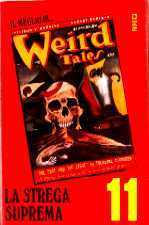
La strega suprema
1987
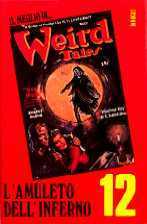
L'amuleto dell'inferno
1987
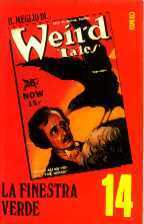
La finestra verde
1988
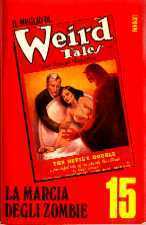
La marcia degli zombie
1988
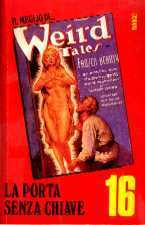
La porta senza chiave
1988

L'ultimo orrore e altri racconti
1990
Authors

Robert Ervin Howard was an American pulp writer of fantasy, horror, historical adventure, boxing, western, and detective fiction. Howard wrote "over three-hundred stories and seven-hundred poems of raw power and unbridled emotion" and is especially noted for his memorable depictions of "a sombre universe of swashbuckling adventure and darkling horror." He is well known for having created—in the pages of the legendary Depression-era pulp magazine Weird Tales—the character Conan the Cimmerian, a.k.a. Conan the Barbarian, a literary icon whose pop-culture imprint can only be compared to such icons as Tarzan of the Apes, Count Dracula, Sherlock Holmes, and James Bond. —Wikipedia Librarian Note: There is more than one author in the Goodreads database with this name.
Grace Jones Morgan (born Grace Ethel Jones) was a Canadian-born pulp fiction writer and novelist. She often used the pseudonym Bassett Morgan. (source: Wikipedia)

Howard Phillips Lovecraft, of Providence, Rhode Island, was an American author of horror, fantasy and science fiction. Lovecraft's major inspiration and invention was cosmic horror: life is incomprehensible to human minds and the universe is fundamentally alien. Those who genuinely reason, like his protagonists, gamble with sanity. Lovecraft has developed a cult following for his Cthulhu Mythos, a series of loosely interconnected fictions featuring a pantheon of human-nullifying entities, as well as the Necronomicon, a fictional grimoire of magical rites and forbidden lore. His works were deeply pessimistic and cynical, challenging the values of the Enlightenment, Romanticism and Christianity. Lovecraft's protagonists usually achieve the mirror-opposite of traditional gnosis and mysticism by momentarily glimpsing the horror of ultimate reality. Although Lovecraft's readership was limited during his life, his reputation has grown over the decades. He is now commonly regarded as one of the most influential horror writers of the 20th Century, exerting widespread and indirect influence, and frequently compared to Edgar Allan Poe. — Wikipedia
Greye La Spina was one of the few women to write regularly for the leading fantasy/horror pulps, and was a contributor to the very first issue of the first American pulp magazine devoted exclusively to tales of horror and the fantastic. Born in Wakefield, Massachusetts, the daughter of a Methodist minister, she was a precocious child, publishing her own "small press" newspaper at the age of 10, with pages of poems and local gossip. As a teenager, she won a literary contest and had a story published in Connecticut Magazine. La Spina gave up writing to attend to her marriage and the raising of a daughter, but in her early thirties she was drawn back to it. In the 1920s and 1930s, La Spina worked as a journalist, and she was said to have been the first female newspaper photographer. Following the death of her husband, La Spina married again, to a deposed Italian baron.
Née Gladys Gordon Trenery Author and pianist Also wrote under the pen name of Marjory E. Lambe
Mary Elizabeth Counselman was an American writer of short stories and poetry. https://en.wikipedia.org/wiki/Mary_El...
Pseudonym of May Eliza Frost Aka May Eliza Harvey, Eliza Mae Harvey. May Eliza Frost went by the name Eli Colter, in print and in her private life. She adopted that name in the early 1920s and used it as her byline in hundreds of stories, serials, and novels, mostly Westerns, but also including what she called "problem life stories" and weird fiction. She was born on September 30, 1890, in Portland, Oregon, where she spent most of the first half of her life. She attended the Ladd School in her native city, but when she was thirteen, blindness struck. She regained her sight and—determined to become a writer—began a course of self-education. May Eliza played piano and pipe organ in movie houses to make her living. In 1922 she submitted a story to Black Mask Magazine. It was her first submission and her first published story. Over the next thirty years, the name Eli Colter became a fixture on the covers of pulp magazines and popular novels. Eli Colter wrote a dozen stories and serials for Weird Tales, beginning with "Farthingale's Poppy" in July 1925. The fourth part of her serial "On the Dead Man's Chest" was voted second most popular of all stories printed in Weird Tales in April 1926. She was in good company, for H.P. Lovecraft came in first with "The Outsider," while Robert E. Howard's "Wolfshead" received third place. Eli Colter topped her previous mark with the most popular stories in January 1927 ("The Last Horror"), August 1927 (part three of the serial "The Dark Chrysalis"), and August 1928 ("The Man in the Green Coat"). "The Last Horror" fell into seventh place among all-time most popular stories behind works by A. Merritt, C.L. Moore, H.P. Lovecraft, Seabury Quinn, Nictzin Dyalhis, and Edmond Hamilton. It was also reprinted in the February 1939 issue and was voted fourth most popular story by readers of Weird Tales for that issue. Despite her popularity, Eli Colter never earned a spot as the author of a cover story for Weird Tales.

Librarian Note: There is more than one author in the Goodreads database with this name. Carl Richard Jacobi was born in Minneapolis, Minnesota in 1904 and lived there throughout his life. He attended the University of Minnesota from 1927 to 1930 where he began his writing career in campus magazines. His first stories were published while he was at the University. The last of these, "Moss Island", was a graduate's contribution to The Quest of Central High School, and "Mive" in the University of Minnesota's The Minnesota Quarterly. Both stories were later sold to Amazing Stories and Weird Tales respectively and marked his debut in professional magazines. "Mive" brought him payment of 25 dollars. He joined the editorial staff of The Minnesota Quarterly, and after graduation in 1931, he became a news reporter for the Minneapolis Star, as well as a frequent reviewer of books and plays. He also served on the staff of the Minnesota Ski-U-Mah, a scholastic publication. After years with the Minneapolis Star, he was the editor for two years of Midwest Media, an advertising and radio trade journal. Later, he devoted himself full-time to writing. He owned his own private retreat, a cabin at Minnewashta in the Carver country outlands of Minneapolis. His intimate familiarity with the terrain and environment there provided the setting for many of his most distinguished stories. Jacobi was a lifelong bachelor. He wrote scores of tales for all the best known magazines of fantasy and science fiction and was represented in numerous anthologies of imaginative fiction published in the United States, England and New Zealand. His stories were translated into French, Swedish, Danish and Dutch. Many of his tales were published in anthologies edited by Derleth, and Arkham House published his first three short story collections. Stories also appeared in such magazines as Short Stories, Railroad Magazine, The Toronto Star, Wonder Stories, MacLean's magazine, Ghost Stories, Strange Stories, Thrilling Mystery, Startling Stories, Complete Stories, Top-Notch and others. Though best known for his macabre fiction, Jacobi also wrote science fiction, weird-menace yarns and adventure stories. From Wikipedia

Nathaniel Hawthorne was a 19th century American novelist and short story writer. He is seen as a key figure in the development of American literature for his tales of the nation's colonial history. Shortly after graduating from Bowdoin College, Hathorne changed his name to Hawthorne. Hawthorne anonymously published his first work, a novel titled Fanshawe, in 1828. In 1837, he published Twice-Told Tales and became engaged to painter and illustrator Sophia Peabody the next year. He worked at a Custom House and joined a Transcendentalist Utopian community, before marrying Peabody in 1842. The couple moved to The Old Manse in Concord, Massachusetts, later moving to Salem, the Berkshires, then to The Wayside in Concord. The Scarlet Letter was published in 1850, followed by a succession of other novels. A political appointment took Hawthorne and family to Europe before returning to The Wayside in 1860. Hawthorne died on May 19, 1864, leaving behind his wife and their three children. Much of Hawthorne's writing centers around New England and many feature moral allegories with a Puritan inspiration. His work is considered part of the Romantic movement and includes novels, short stories, and a biography of his friend, the United States President Franklin Pierce.
Max Brod was a German-speaking Czech Jewish, later Israeli, author, composer, and journalist. Although he was a prolific writer in his own right, he is most famous as the friend and biographer of Franz Kafka. As Kafka's literary executor, Brod refused to follow the writer's instructions to burn his life's work, and had them published instead. http://en.wikipedia.org/wiki/Max\_Brod
Mark Schorer was an American writer, critic, and scholar born in Sauk City, Wisconsin. Schorer earned an MA at Harvard and his Ph.D. in English at the University of Wisconsin–Madison in 1936. During his academic career, he held positions at Dartmouth, Harvard, and the University of California, Berkeley, where he chaired the Department of English from 1960 to 1965. A leading critic of his time, he was best known for his work, Sinclair Lewis: An American Life. Schorer was also the author of many short stories, which appeared in magazines such as The New Yorker, Harpers, The Atlantic Monthly, and Esquire. Among his honors were three Guggenheim Fellowships, a Fulbright professorship at the University of Pisa and a fellowship at the Center for Advanced Study in Behavioral Sciences at Stanford. He also was elected to the American Academy of Arts and Sciences, the most prestigious honor society for creative arts in the country. Schorer was called as an expert witness during the 1957 obscenity trial over the Allen Ginsberg poem Howl, and testified in defense of the poem. This incident is dramatized in the film Howl (2010), in which Schorer is portrayed by Treat Williams. In addition to his scholarly works, he also co-authored a series of science-fiction and horror stories with writer, publisher and childhood friend (both being natives of Sauk City, Wisconsin) August Derleth. These stories, originally published mainly in Weird Tales magazine during the 1920s and 1930s, were eventually anthologized in Colonel Markesan and Less Pleasant People (1966). Schorer died from a blood infection following bladder surgery in Oakland, California at the age of 69.


Emil Petaja (1915 - 2000) was an American science fiction and fantasy writer whose career spanned seven decades. He was the author of 13 published novels, nearly 150 short stories, numerous poems, and a handful of books and articles on various subjects. Though he wrote science fiction, fantasy, horror, detective fiction, and poetry, Petaja considered his work part of an older tradition of "weird fiction." Petaja was also a small press publisher. In 1995, he was named the first ever Author Emeritus by the Science Fiction Writers of America. Of Finnish descent, Petaja's best known works are comprised of a series of science fiction novels based on the Kalevala, the Finnish verse epic. Petaja's series brought him readers from around the world,[1] while his mythological approach to science fiction was discussed in scholarly publications.[2] In a statement published in Contemporary Authors (Gale Research, 1984), Petaja commented, "My writing endeavors have mainly been to entertain, except for the factual material concerning Hannes Bok and fantasy art in general, which serves to indicate my enthusiasm for these subjects. My novels about the Finnish legendary epic Kalevala: The Land of Heroes spring from a lifelong interest in this fine poetic work. I own six translations of the Kalevala, as well as the work in the original. Both of my parents were Finnish."[3]

Alpheus Hyatt Verrill, known as Hyatt Verrill, was an American zoologist, explorer, inventor, illustrator and author. He was the son of Addison Emery Verrill (1839–1926), the first professor of zoology at Yale University. Hyatt Verrill wrote on a wide variety of topics, including natural history, travel, radio and whaling. He participated in a number of archaeological expeditions to the West Indies, South, and Central America. He travelled extensively throughout the West Indies, and all of the Americas, North, Central and South. Theodore Roosevelt stated: "It was my friend Verrill here, who really put the West Indies on the map.” During 1896 he served as natural history editor of Webster's International Dictionary., and he illustrated many of his own writings as well. In 1902 Verrill invented the autochrome process of natural-color photography. Among his writings are many science fiction works including twenty six published in Amazing Stories pulp magazines. Upon his death, P. Schuyler Miller noted that Verrill "was one of the most prolific and successful writers of our time," with 115 books to his credit as well as "articles in innumerable newspapers." Everett F. Bleiler described Verrill's "lost race" stories as "more literate than most of their competition, but stodgy." When the Moon Ran Wild (1962) was published posthumously using the name Ray Ainsbury.
